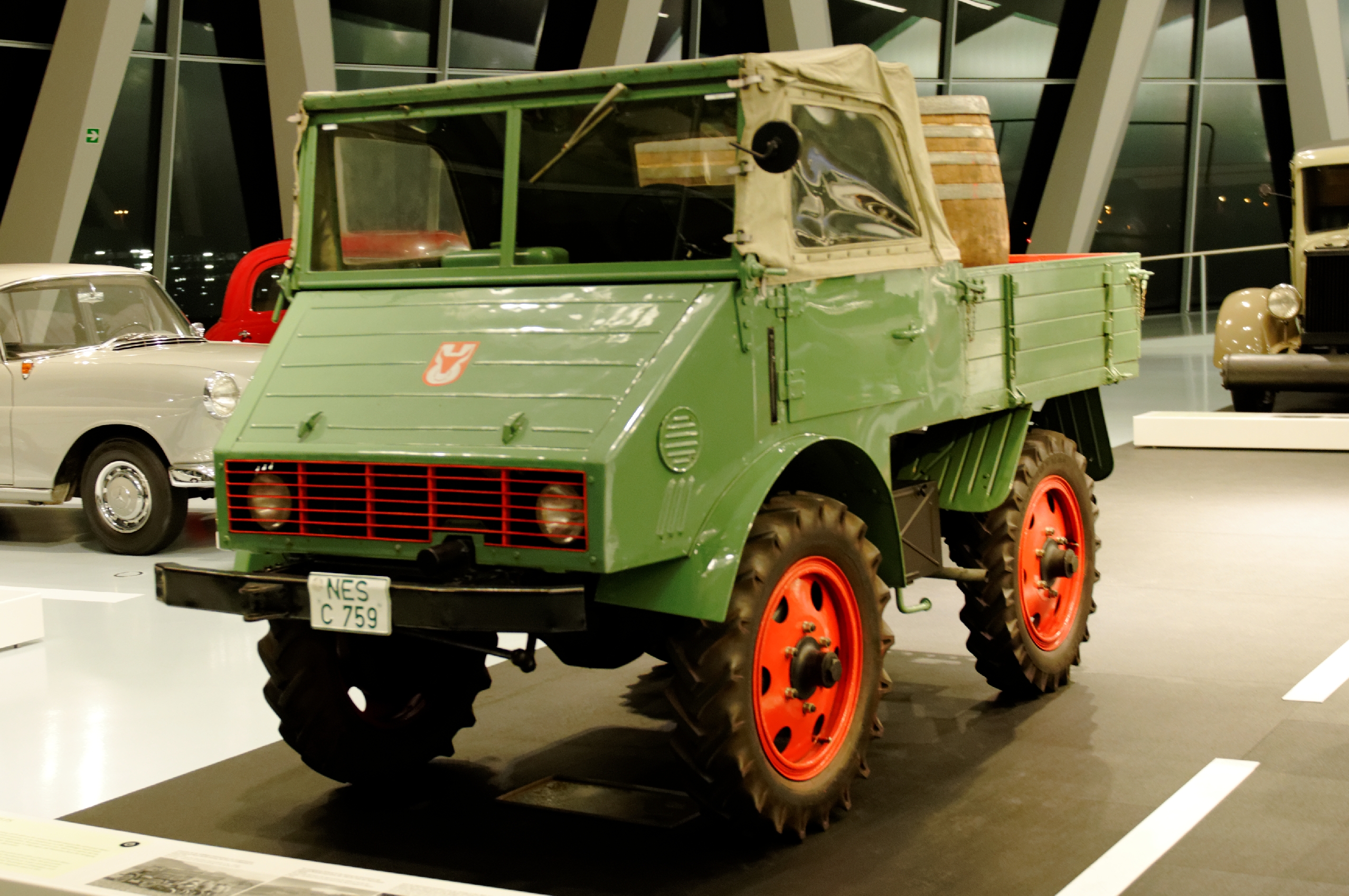
 The Unimog (, ) is a range of multi-purpose tractors, trucks and lorries that has been produced by Boehringer from 1948 until 1951, and by Daimler Truck (formerly Daimler-Benz, DaimlerChrysler and Daimler AG) since 1951. In the United States and Canada, the Unimog was sold as the Freightliner Unimog.
Unimog production started in 1948 at in Göppingen. Daimler-Benz took over manufacture of the Unimog in 1951, and first produced it in their Gaggenau plant. From 1951, the Unimog was sold under the Mercedes-Benz brand. However, the first Unimog to feature the three-pointed Mercedes-Benz star was only introduced in 1953. Since 2002, the Unimog has been built in the Mercedes-Benz truck plant in Wörth am Rhein in Germany. The Mercedes-Benz Türk A.Ş. plant assembles Unimogs in Aksaray, Turkey. Unimogs were also built in Argentina (first ever country to do so outside Germany) by Mercedes-Benz Argentina S.A. under licence from 1968 until 1983 (with some extra units built until 1991 off the assembly line from parts in stock) in the González Catán factory near the city of Buenos Aires.
The first model was designed by Albert Friedrich and Heinrich Rößler shortly after World War II to be used in agriculture as a self-propelled machine providing a
The Unimog (, ) is a range of multi-purpose tractors, trucks and lorries that has been produced by Boehringer from 1948 until 1951, and by Daimler Truck (formerly Daimler-Benz, DaimlerChrysler and Daimler AG) since 1951. In the United States and Canada, the Unimog was sold as the Freightliner Unimog.
Unimog production started in 1948 at in Göppingen. Daimler-Benz took over manufacture of the Unimog in 1951, and first produced it in their Gaggenau plant. From 1951, the Unimog was sold under the Mercedes-Benz brand. However, the first Unimog to feature the three-pointed Mercedes-Benz star was only introduced in 1953. Since 2002, the Unimog has been built in the Mercedes-Benz truck plant in Wörth am Rhein in Germany. The Mercedes-Benz Türk A.Ş. plant assembles Unimogs in Aksaray, Turkey. Unimogs were also built in Argentina (first ever country to do so outside Germany) by Mercedes-Benz Argentina S.A. under licence from 1968 until 1983 (with some extra units built until 1991 off the assembly line from parts in stock) in the González Catán factory near the city of Buenos Aires.
The first model was designed by Albert Friedrich and Heinrich Rößler shortly after World War II to be used in agriculture as a self-propelled machine providing a Etymology
The name ''Unimog'' is pronounced (), and an acronym for the German ''"UNIversal-MOtor-Gerät"'', ''Gerät'' being the German word for a piece of equipment (also in the sense of ''device'', ''machine'', ''instrument'', ''gear'', ''apparatus''). It was created by German engineer Hans Zabel, who made the note ''Universal-Motor-Gerät'' on one of the technical drawings for the Unimog. Later, the ''Universal-Motor-Gerät'' was shortened to the acronym ''Unimog''. On 20 November 1946, the name Unimog was officially unveiled. Since 1952, Unimog has been a brand of Daimler Truck.Features


Design
The Unimog's characteristic design element is itsEquipment
 Unimogs can be equipped with front and rear tool mounting brackets and hydraulic connections to allow bucket loaders and hydraulic arms to be used. Most units have a power takeoff (PTO) connection to operate rotary equipment such as snow brooms, snow blowers, brush mowers, loaders or stationary conveyor belts.
Unimogs can be equipped with front and rear tool mounting brackets and hydraulic connections to allow bucket loaders and hydraulic arms to be used. Most units have a power takeoff (PTO) connection to operate rotary equipment such as snow brooms, snow blowers, brush mowers, loaders or stationary conveyor belts.
Variants
Unimogs are available with short wheelbases for implement carrier operations or long wheelbases for all-terrain cargo carrying operations. Currently (2022), Daimler Trucks offers the 437.4 heavy series and the 405 implement carrier series. Starting in 1951 having purchased the traditional Unimog from Boehringer, Daimler-Benz started making the Unimog S series in the mid-1950s and added light, medium and heavy series to the model lineup in the 1960s and 1970s, before they successively reduced the available models during the 1990s to end up with the modern implement carrier and the heavy series today. Originally, the traditional Unimog 70200 was a rather small agricultural tractor, measuring just 3,520 mm in length. It was only offered as a Cabrio with a canvas roof. The engine power output of 25 DIN-PS (18.5 kW) proved to be insufficient for many applications. To accommodate customer needs, a longer wheelbase version, a proper cab and more powerful engines (up to 34 DIN-PS (25 kW)) were introduced soon after Daimler-Benz took over Unimog manufacture; the traditional Unimog evolved into its final stage, the 411-series. Yet, Daimler-Benz decided that an entirely new, more powerful version of the Unimog would be required to meet future customer expectations. This Unimog version would later be known as 406-series. The military Unimog S series is the first Unimog designed to be an offroad truck rather than a tractor, and it is the only series production Unimog that has an Otto engine.In this article, the terms Otto cycle engine and Diesel cycle engine are used to differentiate between a traditional petrol engine and a traditional Diesel engine. This is because the original Unimog does not only have a Diesel engine that can burn petrol (precombustion chamber design), but also used to require petrol as a fuel additive in winter to prevent the fuel from gelling. Furthermore, many German military vehicles (such as the Unimog S) have petrol engines, but several military petrol engines use the Diesel principle. Daimler-Benz designed a new frame for it, but it still shares its drivetrain with the 411-series. With the introduction of the 406-series in 1962, Daimler-Benz laid the foundation for a completely new Unimog model family, the 406-based medium series (in the 1960s known as ''heavy'' series). It was produced until 1994. Unimogs belonging to the medium series are the series 403, 413, 406, 416, 426, and 419. These models were offered with three different wheelbases (2,380 mm, 2,900 mm, 3,400 mm) and two engines, the straight-four and straight-six direct injected Diesel engines OM 314 and OM 352, ranging from 54 DIN-PS to 110 DIN-PS (40 kW – 81 kW). The light series 421 and 431 share their frame design with the 411-series, but borrow their drivetrain and cab design from the 406-series, which is why they also count as 406-related Unimogs. The heavy series Unimogs were introduced in 1974, and first featured the edgy cab, which is still a design feature of the Unimog today. The first heavy series Unimog was the 425-series, which was available from 1976.Mercedes-Benz presented the 425 in 1974, and the 435 in 1975. Series production started in January 1976. Soon after, the 435-series and 424-series followed, which caused a decline in Unimog 406 sales.The 425 was available with a wheelbase of 2,810 mm, the 424 with 2,650 mm and 3,250 mm, and the 435 with 3,250 mm, 3,700 mm and 3,850 mm. The introduction of new engines starting in 1986 caused a shift in the series numbers, but leaving the vehicles mostly unchanged otherwise. The 424 became 427 and both 425 and 435 were joined together and became 437. A derivative of the 437-series, the 437.4-series is still in production today. In 1988, after declining Unimog sales, Daimler-Benz launched a new strategy that was supposed to increase sales and make the Unimog more profitable, called "Unimog-Programm 1988". New models introduced with this programme were the new light series 407 and medium series 417, which ought to replace all Unimog 406-related series. 407- and 417-series were replaced after just four years, in 1992, with the 408- and 418-series. in 2000, these two models were replaced with the current 405 implement carrier series, making the 437.4 and theTechnical description
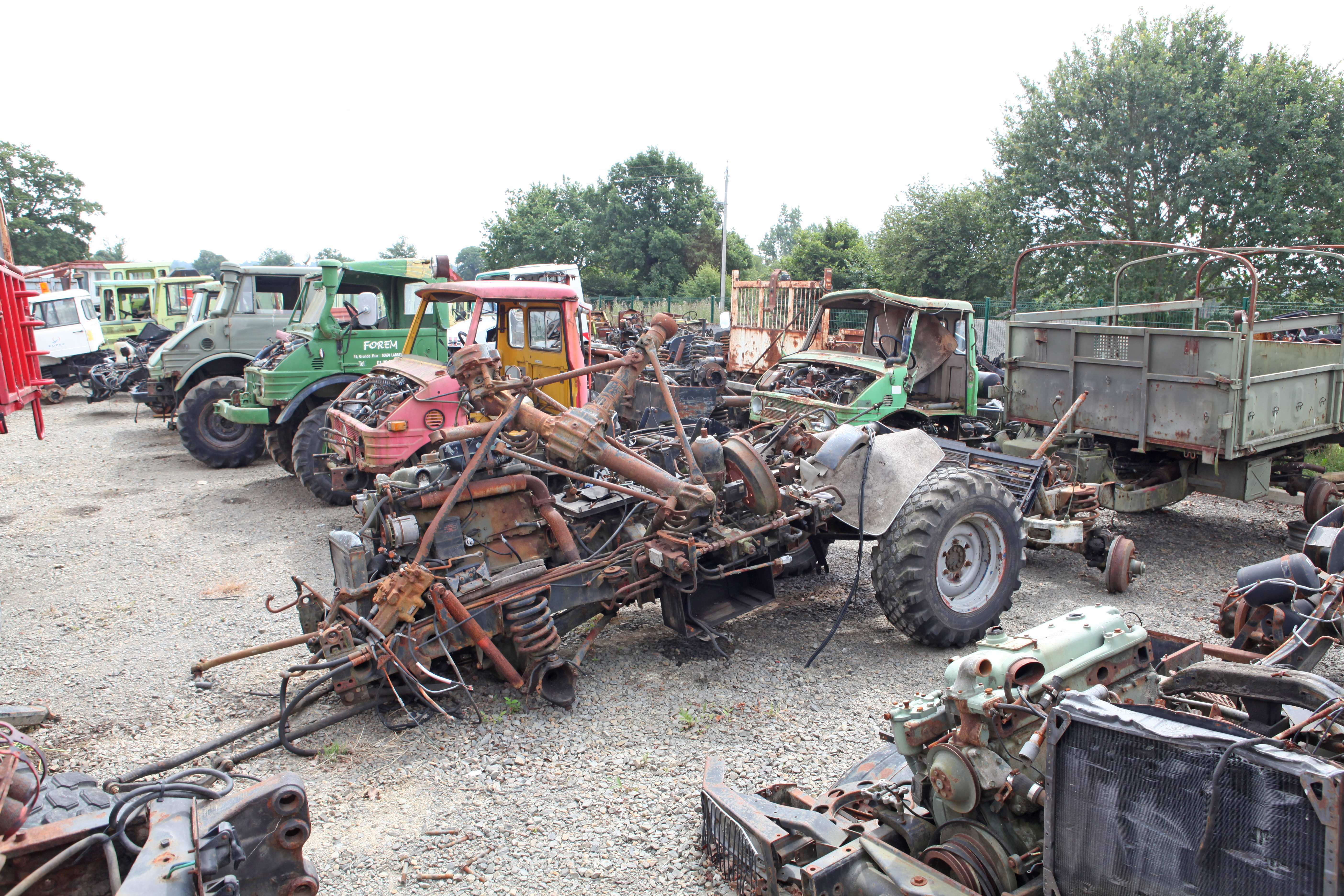
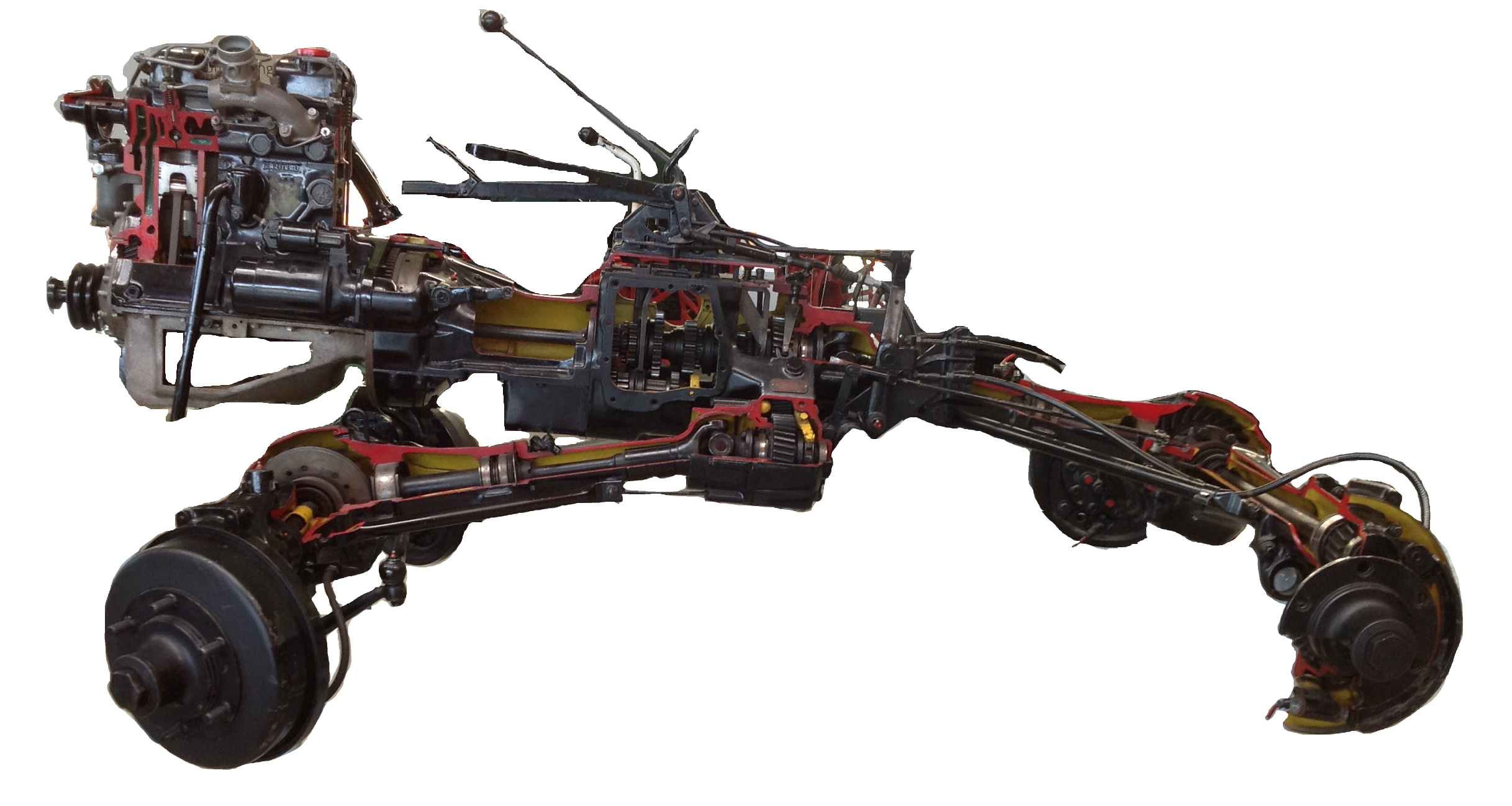



Chassis
Like other trucks, but unlike agricultural tractors, the Unimog is a body-on-frame vehicle with short overhangs. The original Unimog was made with a plane ladder frame and a wheelbase of 1720 mm. Later, the wheelbase was extended several times to accommodate customer needs. Starting in the mid-1950s, with the introduction of the Unimog 404, the frame received a drop. Originally, this was done to make space for a spare tyre, but soon engineers found out that the new frame would improve the torsion performance, which is why all following Unimog series also received a frame with a drop. Several mounting brackets, additional cross members and tool boards were offered as factory options for the frame.Suspension
The Unimog has live front and rear axles that have portal gears (Drivetrain
The classical Unimog is rear-wheel drive vehicle, meaning that the rear axle is directly connected to the gearbox. Turning on front wheel drive automatically locks both axles, without torque compensation. The mechanical lever that turns on all wheel drive has a third position that locks front- and rear differentials. As of 1963, a pneumatic power switch was used instead of a lever. Due to the reduction gears inside the portal axles, the rotational frequency of the driveshafts inside the torque tubes is relatively high, meaning that the amount of torque they have to withstand is fairly low.Gearbox
Traditionally, the Unimog has a splitter gearbox. Over the years, three different ''base gearbox'' designs have been used, all following the same principle, and having four gears and two ranges (called ''groups'') and an additional direction gear. Those designs were ''UG-1/xx'', ''UG-2/xx'', and ''UG-3/xx''. UG is an abbreviation for ''Unimog-Getriebe (Unimog-Gearbox)'', the number after the slash resembles the input torque in kp·m (=9.80665 N·m).The kilopondmetre (kp·m) is the traditional technical unit of torque used in many European countries until the early 1980s. It equals the force that a mass of 1 kilogram applies. If the acceleration is exactly 9.80665 m·s−2 (default gravitational acceleration), this equals 9.80665 N·m. Until 1955, the Unimog ''base gearbox'' UG-1 was a constant-mesh countershaft gearbox, it was then upgraded with synchroniser rings to a synchromesh gearbox. However, the synchromesh-version was only used for the 404-series, and the constant-mesh version remained the standard gearbox for the 411-series. In 1957, the synchromesh-version became an option for the 411-series, before it became the standard gearbox for all Unimogs in 1959. The following gearbox versions UG-2 and UG-3 were made as synchromesh versions only. There are different ''layouts'' of the gearbox, namely ''F-layout'' and ''G-layout'' as well as their upgraded layouts, not having particular names. The F-layout is the original gearbox layout and is limited to the first two gears in the first range as it does not have selector sleeves, meaning that in total there are six forward gears. Instead of a reverse gear, the gearbox has its direction gear, which, in theory, can be used to reverse any gear. Due to the lacking shifting sleeves however, the reverse direction can only be used in the first range, which itself is limited to the first two gears, resulting in only two reverse gears (resulting in six forward and two reverse gears). To operate the gearbox, there is only one shift lever with a six-speed H-layout, the gearbox shifts its ranges automatically. An additional shift lever is used for shifting into reverse. The ''G-layout'' has an additional reduction gearbox, which can be used in all gears. This effectively doubles the number of gears (twelve forward and four reverse gears). This reduction gearbox was also available with an additional crawler gear, which can only be used in the first range (twenty forward and eight reverse gears). As of 1976, shifting sleeves were added and a four-speed-H-layout replaced the six-speed-H-layout, which allows using all gears in all ranges.Helmut Schmitz:Getriebevarianten U 406/U 421
'. August 20th, 2012. Retrieved May 19th, 2017 (in German) With the introduction of the UG-3-gearbox, the standard gearbox-shifter-layout was changed to an eight-speed-H-H-layout, with eight gears on one lever, without any additional switches. When shifting from "4th" into "5th" gear, the gearbox automatically shifts into range 2 and back into gear 1. Crawler gearboxes were offered as a factory option for the UG-3 gearbox as well, resulting in 24 gears. The design with the additional direction gear was kept, which means that all 24 gears can also be used in reverse mode. Since the highest final gear ratio allows top speeds of up to 110 km/h, and the reverse gear only comes with a small reduction of 1:1.03, the top speed in reverse mode is more than 100 km/h. To prevent such high reverse speeds, a lock for the second range was available as a factory option, allowing only the first range (gears "1" to "4") in reverse mode.
Engine
The initial Unimogs were equipped with passenger car engines, the first Unimog series to receive a truck engine was the 406-series in 1963. All engines use the Diesel principle, except for engines used for the Unimog 404-series and the first four Unimog prototypes, which use the Otto principle. The following engines were used as of 1947, with ''M'' being Otto and ''OM'' being Diesel engines (the list is incomplete): * M 136 * M 130 * M 180 * OM 636 * OM 621 * OM 615 * OM 616 * OM 312 * OM 314 * OM 352 * OM 353Cab
Traditionally, three different cab options were available for the Unimog: An open roof cab (Cabrio), single cab and double cab, with the single cab being the most popular. Because the Unimog was designed to be a better agricultural tractor, its original design did not include a closed cab (as agricultural tractors in Germany usually did not have a closed cab in the 1940s). The first Unimog series to be officially offered with a cab was the 401-series. However, the first cabs were made by Westfalia in Rheda-Wiedenbrück and then shipped to the Unimog plant in Gaggenau for assembly. These cabs are known as ''Westfalia type B'' or simply ('frog's eye'). Starting in 1957, a new cab with 30% more volume, called ''Westfalia type DvF'', Typ D, (Type D, widened cab), was used. Both Westfalia cabs were fairly narrow and came with the problem of engine heat causing high cabin temperatures. The first Unimog that was designed with a cab was the series 406. Just for the purpose of manufacturing cabs, Daimler-Benz built a new 1000- Megapond-sheet-panel-press in the Unimog plant. It was planned that the double cab parts would also be produced with this press, instead, the double cabs were manufactured by Wackenhut in Nagold. In 1974, the current heavy-duty-series' cab was introduced. Its basic design has not been changed since. The equipment carrier versions' cab on the other hand has received several modifications since its introduction in the late 1980s, with the current version being introduced in 2000.Pneumatics and hydraulics
The original Unimog was offered with a pneumatic system. This system was used for powering all auxiliary devices as well as the three-point linkages. As of October 1961, a hydraulics system became an option, and as of 1963, the hydraulics system became standard, but unlike the pneumatics system, the hydraulics system was made by Westinghouse Air Brake Company in Hannover. With the introduction of the hydraulics system, the pneumatics system was solely used for operating the brakes.Users
Military
Officially, the Unimog was never meant to be a military vehicle; in fact, Allied permission to develop the Unimog was granted only because Albert Friedrich, inventor of the Unimog, ensured that the Unimog would not have any military purpose. However, the Unimog has always been a military vehicle. 44 Unimogs of the first model, the Unimog 70200, served as combat engineer tractors in the Swiss army. They proved successful, and the Swiss army purchased 540 units of the 70200's successor, theCivilian
Unimogs are used by the German emergency management agency Technisches Hilfswerk (THW),(literally ''Technical Relief Organization''), byNorth America
 Unimogs have been uncommon in North America because of differing vehicle regulations and requirements from those in Germany and Europe, and due to the lack of a North American sales and support network. Most Unimog models found in North America have been imported by individual dealers or independent enthusiasts.
Between 1975 and 1980 the Case Corporation (now merged into CNH Global) imported the U-900 model into the United States and sold it through Case tractor dealerships as the MB4/94.
In 2002 DaimlerChrysler tried to re-enter the North American market with the Unimog and engaged in four years of aggressive marketing, which included activities such as; truck and trade shows, exposure on the television show '' Modern Marvels'', numerous magazine articles and extensive demonstrations (both touring and on an individual basis). They were generally sold through Freightliner truck dealerships. Freightliner is a Daimler AG subsidiary. The UGN series was specifically manufactured for the North American market and was significantly different mechanically from its European counterpart. The UGN faced stiff competition in North America by manufacturers whose truck or equipment lines performed some of the same duties as the Unimog. Some of them are
Unimogs have been uncommon in North America because of differing vehicle regulations and requirements from those in Germany and Europe, and due to the lack of a North American sales and support network. Most Unimog models found in North America have been imported by individual dealers or independent enthusiasts.
Between 1975 and 1980 the Case Corporation (now merged into CNH Global) imported the U-900 model into the United States and sold it through Case tractor dealerships as the MB4/94.
In 2002 DaimlerChrysler tried to re-enter the North American market with the Unimog and engaged in four years of aggressive marketing, which included activities such as; truck and trade shows, exposure on the television show '' Modern Marvels'', numerous magazine articles and extensive demonstrations (both touring and on an individual basis). They were generally sold through Freightliner truck dealerships. Freightliner is a Daimler AG subsidiary. The UGN series was specifically manufactured for the North American market and was significantly different mechanically from its European counterpart. The UGN faced stiff competition in North America by manufacturers whose truck or equipment lines performed some of the same duties as the Unimog. Some of them are Motorsport
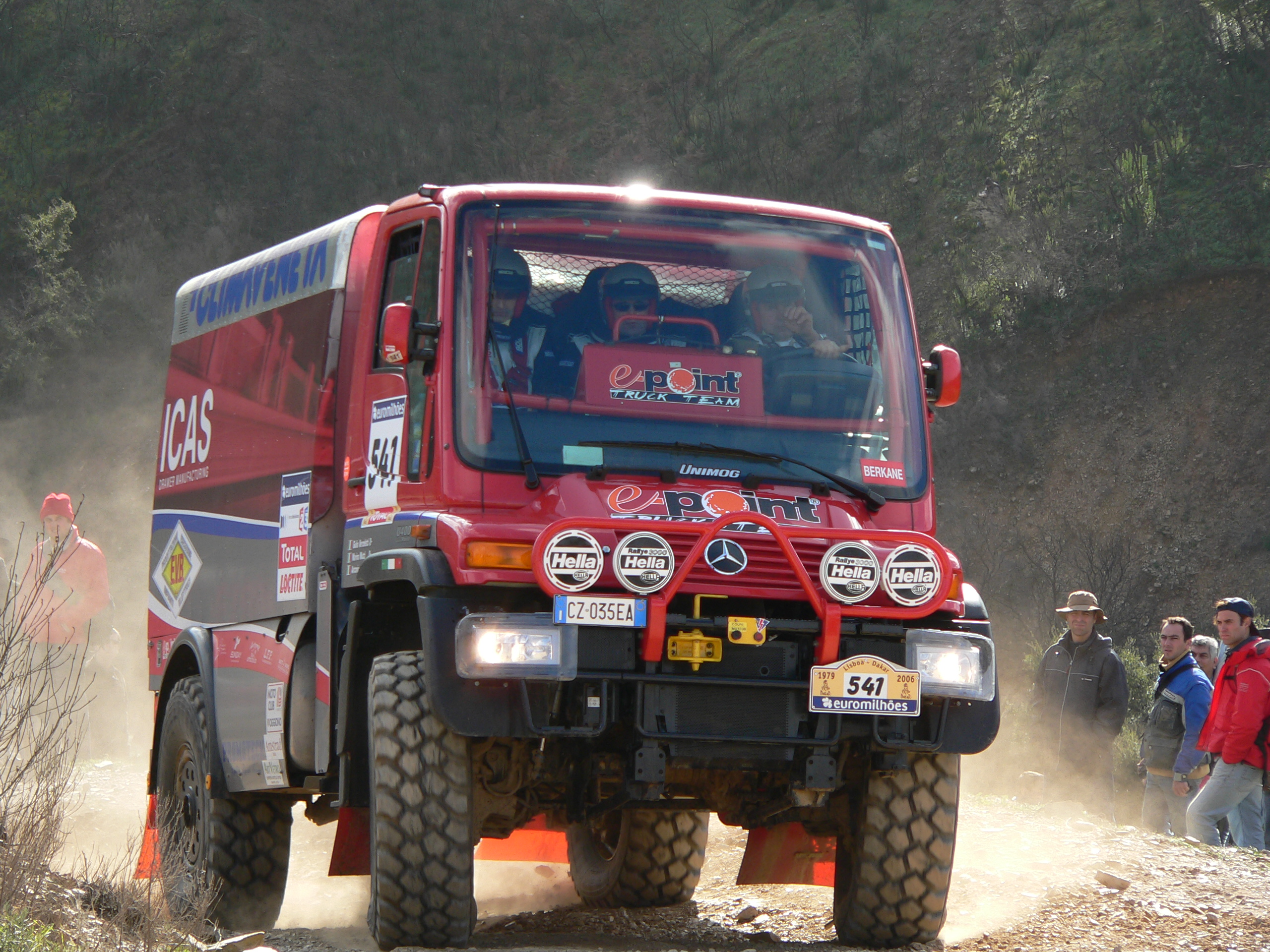
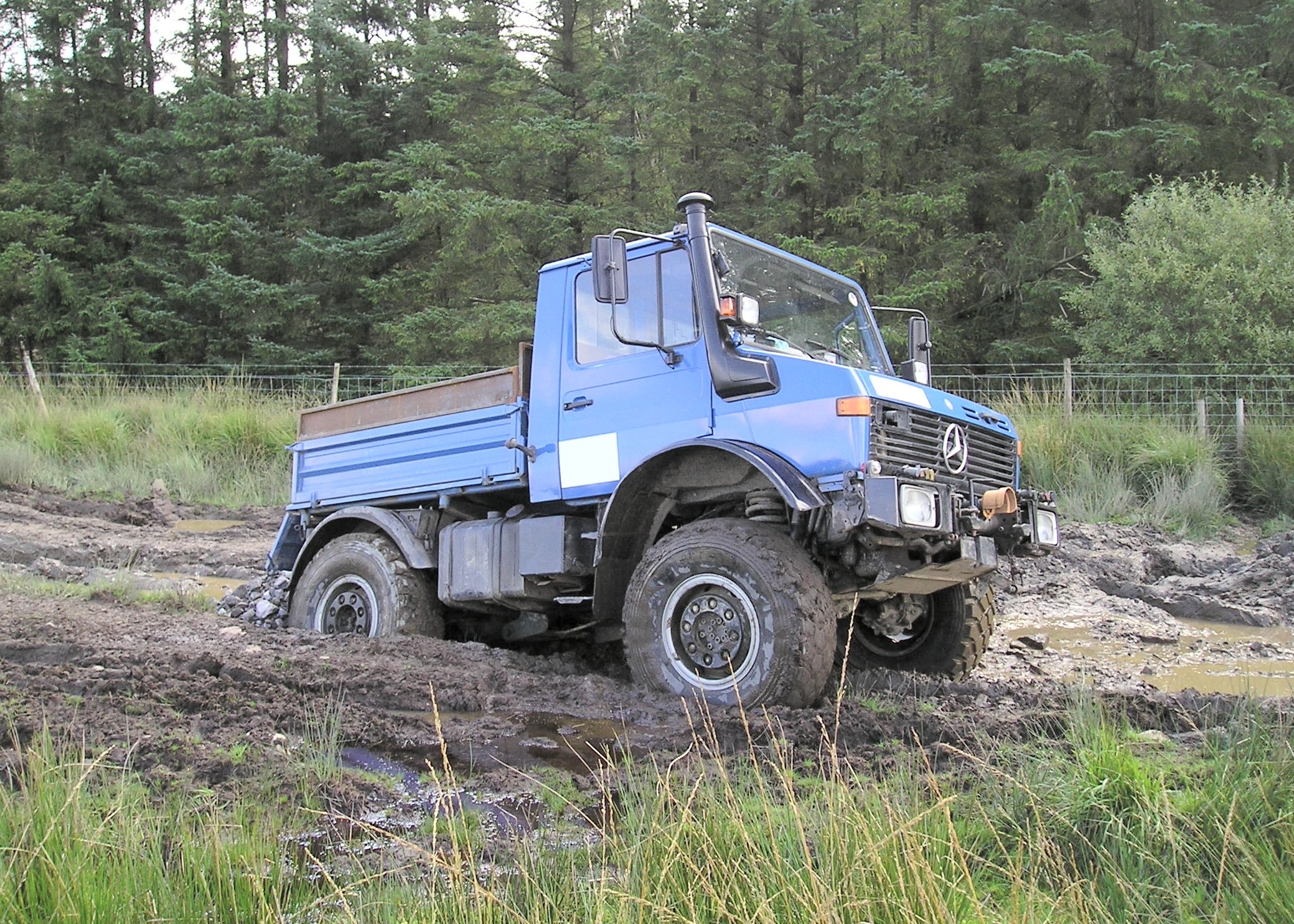 Unimogs have been used in three kinds of competition: Dakar Rally and other desert rally competitions, mud bogging, and slow-moving Truck Trials over obstacles.
Unimogs have won the truck class of the Dakar in 1982 and 1986, the latter an unexpected victory as the vehicle participated for Honda, primarily to provide support for the motorcycles of the team. High-powered factory-sponsored entries of truck companies aiming for the overall win have since taken the laurels, with Unimogs used mainly for service purposes.
Unimogs have been used in three kinds of competition: Dakar Rally and other desert rally competitions, mud bogging, and slow-moving Truck Trials over obstacles.
Unimogs have won the truck class of the Dakar in 1982 and 1986, the latter an unexpected victory as the vehicle participated for Honda, primarily to provide support for the motorcycles of the team. High-powered factory-sponsored entries of truck companies aiming for the overall win have since taken the laurels, with Unimogs used mainly for service purposes.
Derivatives
MB Trac
In 1973 the Unimog department in Gaggenau also designed the MB Trac, a more tractor-like version. It was produced by Daimler-Benz until 1991, when the product line was sold to Werner Forst- und Industrietechnik, who continues to produce it as the WF trac. It is sold and maintained by Mercedes Unimog dealers.Military derivatives
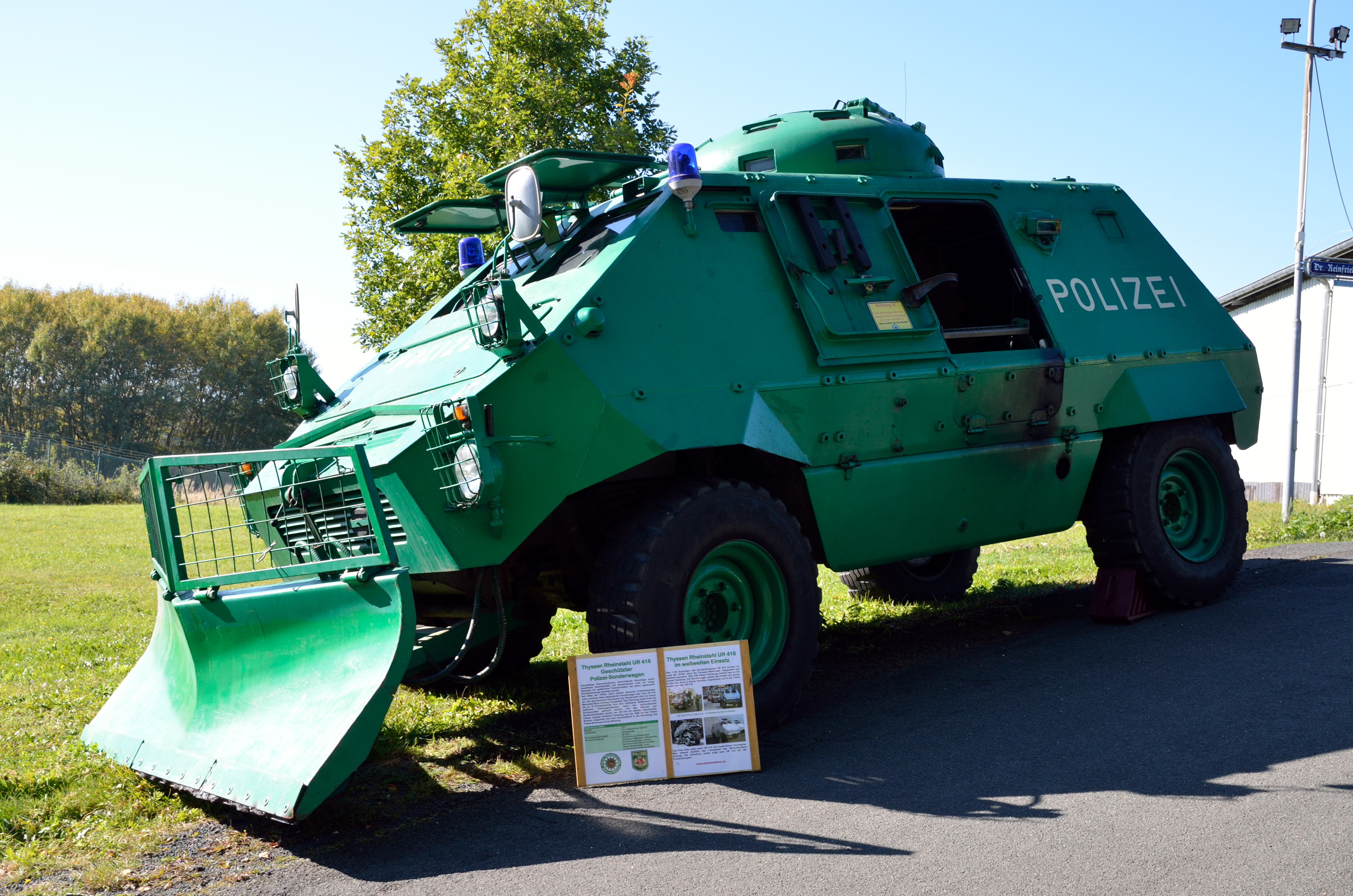 The Unimog also serves as a technical platform for armoured vehicles like the ATF Dingo, a mine-protected utility and reconnaissance vehicle used by the German and other European Armed Forces (e.g. Belgium) for territorial defence purposes as well as in international missions.
In late Autumn 1956, Daimler-Benz started developing a new military version of the Unimog, the ''Unimog SH''. It was based on the
The Unimog also serves as a technical platform for armoured vehicles like the ATF Dingo, a mine-protected utility and reconnaissance vehicle used by the German and other European Armed Forces (e.g. Belgium) for territorial defence purposes as well as in international missions.
In late Autumn 1956, Daimler-Benz started developing a new military version of the Unimog, the ''Unimog SH''. It was based on the History
1940s
1945 – First prototype
1947 – Production
 The 25-PS (18 kW) OM 636 Mercedes-Benz Diesel engine became standard equipment in the first production Unimogs at the end of 1947. The original emblem for the Unimog was a pair of ox horns in the shape of the letter U. The first 600 units of the 70200 series Unimogs were built by Boehringer. This was done mainly for two reasons: Erhard und Söhne did not have the capacity to build the Unimogs and Boehringer (a former tool manufacturer) could evade dismantling.
The 25-PS (18 kW) OM 636 Mercedes-Benz Diesel engine became standard equipment in the first production Unimogs at the end of 1947. The original emblem for the Unimog was a pair of ox horns in the shape of the letter U. The first 600 units of the 70200 series Unimogs were built by Boehringer. This was done mainly for two reasons: Erhard und Söhne did not have the capacity to build the Unimogs and Boehringer (a former tool manufacturer) could evade dismantling.
1950s
 In late 1950, Mercedes-Benz entered into a contract with Boeringer to take over production of the Unimog.
In late 1950, Mercedes-Benz entered into a contract with Boeringer to take over production of the Unimog.
1951 – Daimler-Benz – Gaggenau manufacturing plant
Daimler-Benz modified the Unimog for mass production to create the series 2010 and in 1951, started its manufacture in their Gaggenau plant in Baden-Württemberg, where production continued until 2002.1953 – The 401, 402 and the closed cab
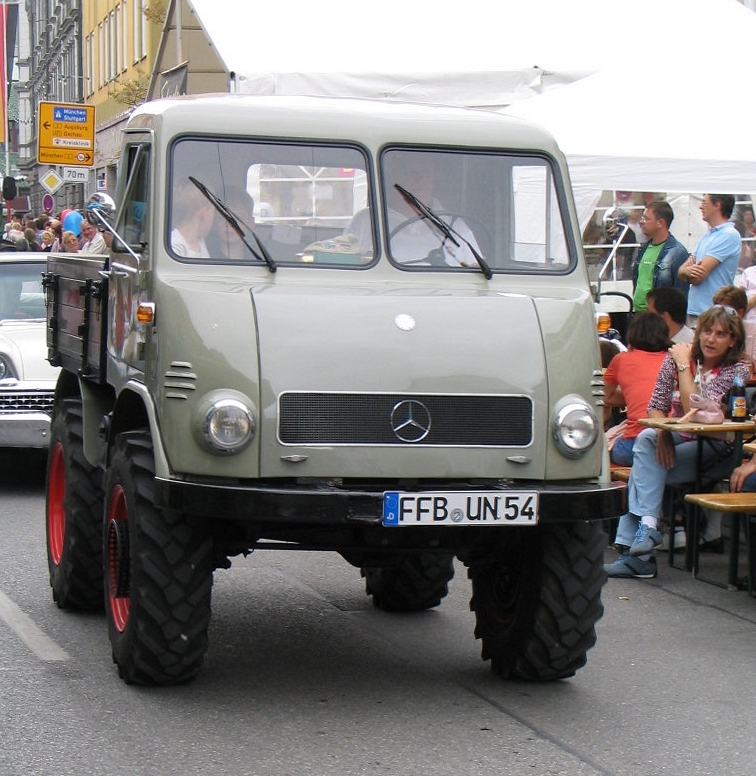 In 1953, the Unimog was updated and the three-pointed Mercedes star began to appear on the bonnet, replacing the Unimog ox horn emblem. The new model became known as the series 401. A new series 402 with a long wheelbase chassis ( instead of ) also became available.
An enclosed driver's cab was available as an option from 1953, making the Unimog a true all-weather vehicle.
In 1953, the Unimog was updated and the three-pointed Mercedes star began to appear on the bonnet, replacing the Unimog ox horn emblem. The new model became known as the series 401. A new series 402 with a long wheelbase chassis ( instead of ) also became available.
An enclosed driver's cab was available as an option from 1953, making the Unimog a true all-weather vehicle.
1955 – The 404 S
In 1955, the first Unimog 404 S series were produced. The primary customer of the 404 S was the Bundeswehr (literally ''Federal Defence'', i.e. the West German Armed Forces), which was created in the mid-1950s in the era of the1957
Starting in 1957, the Unimog 411 was offered with a synchromesh gearbox as an option, and in 1959, the synchromesh gearbox became standard.1960s
1970s
1972 – MB Trac
 Despite originally being designed as an agricultural vehicle, the Unimog had more success as a multi-purpose tool carrier. To actually serve the agricultural market, Daimler-Benz designed a completely new agricultural tractor in 1972, the MB Trac. It is a body-on-frame design ''trac''-tractor, has four big wheels of the same size, and all-wheel-drive, a slim bonnet, and an angular driver cab. In contrast to conventional tractors the cab is situated between the axles, similar to comparable four-wheel-drive tractors. There is no articulation between the front and rear sections, instead, the MB Trac has conventional steering.
A wide range of MB Trac tractors were offered, ranging from the entry model MB-trac 65 to the top model MB Trac 1800 intercooler. Daimler-Benz later merged the MB-trac with the agricultural machinery activities of Deutz AG. The manufacturing of the MB Trac series ceased in 1991.
Despite originally being designed as an agricultural vehicle, the Unimog had more success as a multi-purpose tool carrier. To actually serve the agricultural market, Daimler-Benz designed a completely new agricultural tractor in 1972, the MB Trac. It is a body-on-frame design ''trac''-tractor, has four big wheels of the same size, and all-wheel-drive, a slim bonnet, and an angular driver cab. In contrast to conventional tractors the cab is situated between the axles, similar to comparable four-wheel-drive tractors. There is no articulation between the front and rear sections, instead, the MB Trac has conventional steering.
A wide range of MB Trac tractors were offered, ranging from the entry model MB-trac 65 to the top model MB Trac 1800 intercooler. Daimler-Benz later merged the MB-trac with the agricultural machinery activities of Deutz AG. The manufacturing of the MB Trac series ceased in 1991.
1974 – Heavy series
In 1974, Mercedes-Benz presented the new Unimog U 120. It was the first model of the "heavy duty" Unimog series 425. The heavy duty series, or simply "heavy" series, extended the Unimog model lineup. The characteristic "edgy" bonnet introduced with the heavy Unimog series remains am Unimog style element to this day. The series 425 have a wheelbase, 9 t permissible maximum mass and an OM 352 Diesel engine producing (shortly thereafter as U 125).1975 – Series 435
Manufacture of the series 435 for the Bundeswehr began in 1975, as a successor of the Unimog S 404. The 435 was characterized by a long wheelbase of , or and shares its cab with the series 425.1976 – Unimog models renamed
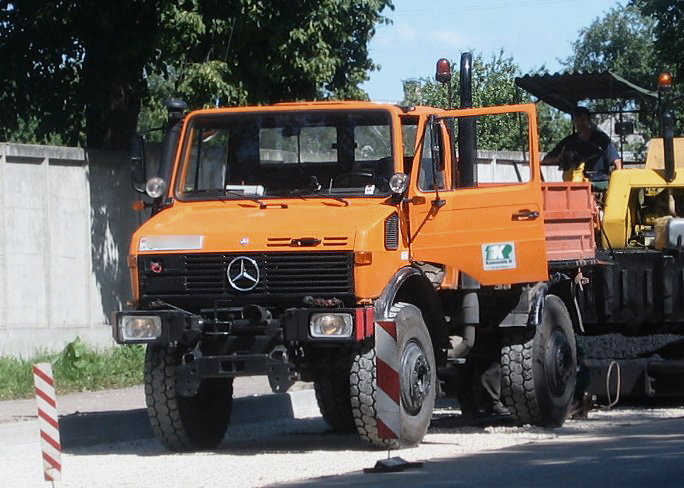 The new 424 "middle" series of Unimogs was produced starting from 1976. They share the cab with the series-425 and are designated U 1000, U 1300/L, U 1500, and U 1700/L with engine performance.
In the same period Daimler-Benz re-ordered the type designations for the older series. The classical round form series of the Unimog were now designated U 600/L, U 800/L, U 900 and U 1100/L. (The letter L stands for a long wheelbase, because most models were available in two wheelbase variants.)
The Unimog with the rounded driving cab became known as the ''light'' series. The new series with angular cab was divided by payload into a ''middle'' and ''heavy'' series. Some engines overlap – the Unimog nomenclature is not simple to understand (see below for notes on series names).
The long-proven Unimog-S (404), although with clearly decreasing production figures, was the only Unimog with an Otto cycle engine in the lineup.
With the exception of the entry-level model, all Unimogs for 1976 were equipped with four wheel
The new 424 "middle" series of Unimogs was produced starting from 1976. They share the cab with the series-425 and are designated U 1000, U 1300/L, U 1500, and U 1700/L with engine performance.
In the same period Daimler-Benz re-ordered the type designations for the older series. The classical round form series of the Unimog were now designated U 600/L, U 800/L, U 900 and U 1100/L. (The letter L stands for a long wheelbase, because most models were available in two wheelbase variants.)
The Unimog with the rounded driving cab became known as the ''light'' series. The new series with angular cab was divided by payload into a ''middle'' and ''heavy'' series. Some engines overlap – the Unimog nomenclature is not simple to understand (see below for notes on series names).
The long-proven Unimog-S (404), although with clearly decreasing production figures, was the only Unimog with an Otto cycle engine in the lineup.
With the exception of the entry-level model, all Unimogs for 1976 were equipped with four wheel 1977 – 200,000th Unimog
The 200,000th Unimog, a 424.121, was produced in 1977.1980s
 In 1980, production of the U 404 (Unimog S) ended.
The light and medium series 407 and 427 were introduced in 1985.
Production of the 406 and 416 ceased in 1988 and the 437-series was introduced the same year.
In 1980, production of the U 404 (Unimog S) ended.
The light and medium series 407 and 427 were introduced in 1985.
Production of the 406 and 416 ceased in 1988 and the 437-series was introduced the same year.
1990s
1992 – New light models
 In the early 1990s, the new light models 408 (U 90) and 418 (U 110-U 140) with newly designed cabins were introduced to replace the predecessor models. The new very diagonal front portion gives the operator a good overview forward. The 408 features an asymmetric front bonnet, which is lower on the driver's side. This is supposed to permit the driver a good overview. A new ladder frame and progressively working coil springs to improve the Unimog's handling were implemented. In addition to that, the Unimog received a new tyre pressure adjustment system that can be operated whilst driving, an anti-skid system, new engines, and a "Servolock" mechanism for the hydraulic connection of implements.
In the early 1990s, the new light models 408 (U 90) and 418 (U 110-U 140) with newly designed cabins were introduced to replace the predecessor models. The new very diagonal front portion gives the operator a good overview forward. The 408 features an asymmetric front bonnet, which is lower on the driver's side. This is supposed to permit the driver a good overview. A new ladder frame and progressively working coil springs to improve the Unimog's handling were implemented. In addition to that, the Unimog received a new tyre pressure adjustment system that can be operated whilst driving, an anti-skid system, new engines, and a "Servolock" mechanism for the hydraulic connection of implements.
1994 – The "Funmog"
In March 1994, Mercedes-Benz presented the design concept "Funmog", a luxury version of the Unimog, on the International Off-Road-Exhibition in Köln, Germany. It was based on the 408-seriesDaimler-Benz AG (ed):Unimog Studie „Funmog" präsentiert
'. 15 March 1994. Retrieved 30 December 2018 and only built for customers who special-ordered it. Until 1997, Daimler-Benz made exactly 12 units of the Funmog,Rhein Zeitung:
'. 6 August 1997. Retrieved 30 December 2018 out of which most were exported to Japan. The Funmog features chrome bull bars, and air horns, but lacks hydraulics and is limited to a total mass of 5,000 kg. Mercedes-Benz offered luxury options such as leather seats, fine carpeting and other interior modifications for the Funmog. Starting price was DM 140,000.
1995 – U 2450 L 6×6
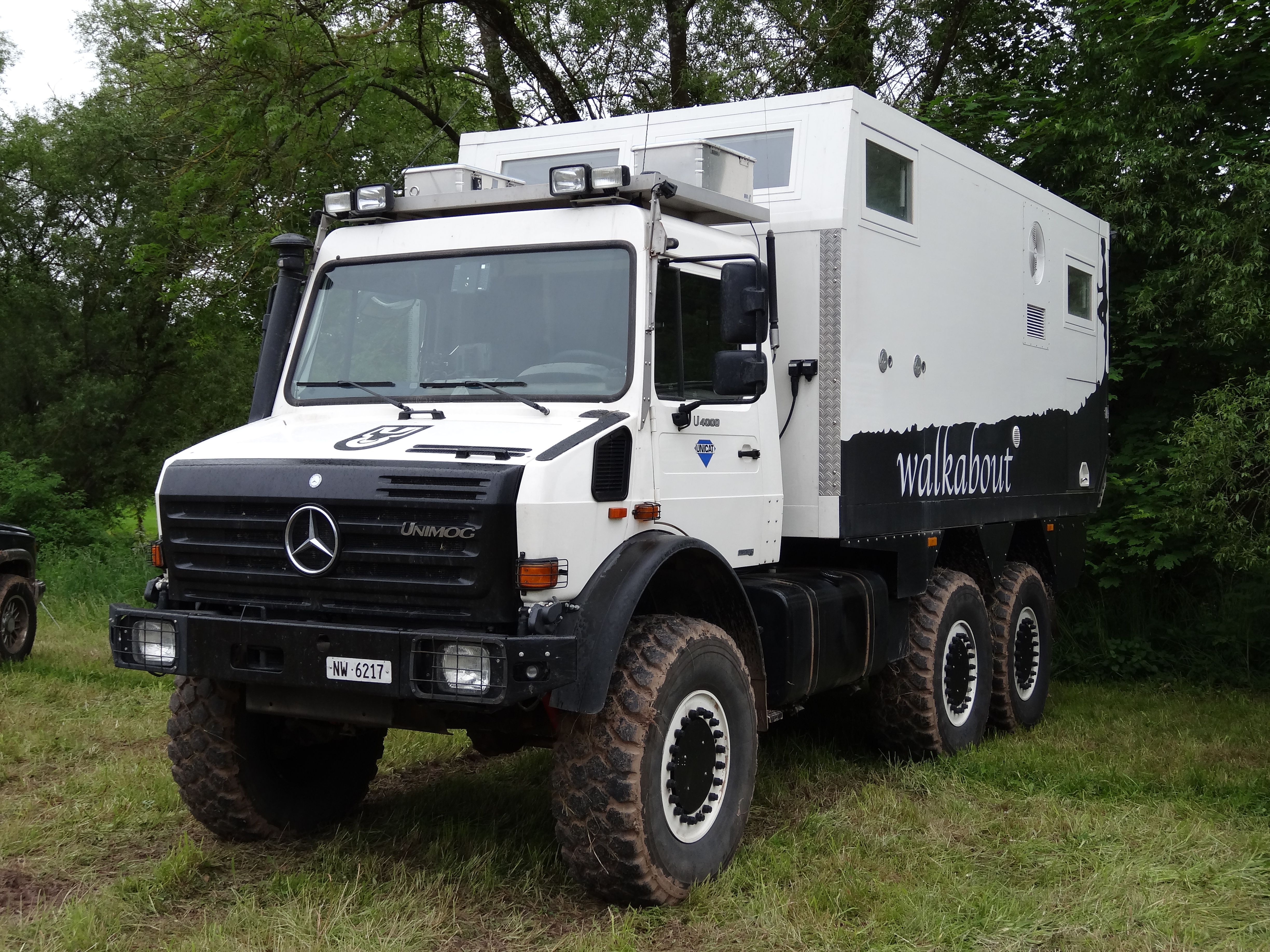 In 1995, the Unimog U 2450 L 6×6 (437.156), an all-wheel-drive, 3-axle Unimog version, was presented.
In 1995, the Unimog U 2450 L 6×6 (437.156), an all-wheel-drive, 3-axle Unimog version, was presented.
1996 – UX 100
Mercedes-Benz presented the Unimog 409 (officially called UX 100) in 1996. It is the smallest Unimog model ever made and designed to slip speedily over sidewalks and around plants. Within a few years, production of the UX 100 was transferred to the Multicar subsidiary of Hako GmbH, who specialize in vehicles of this kind and size.2000s
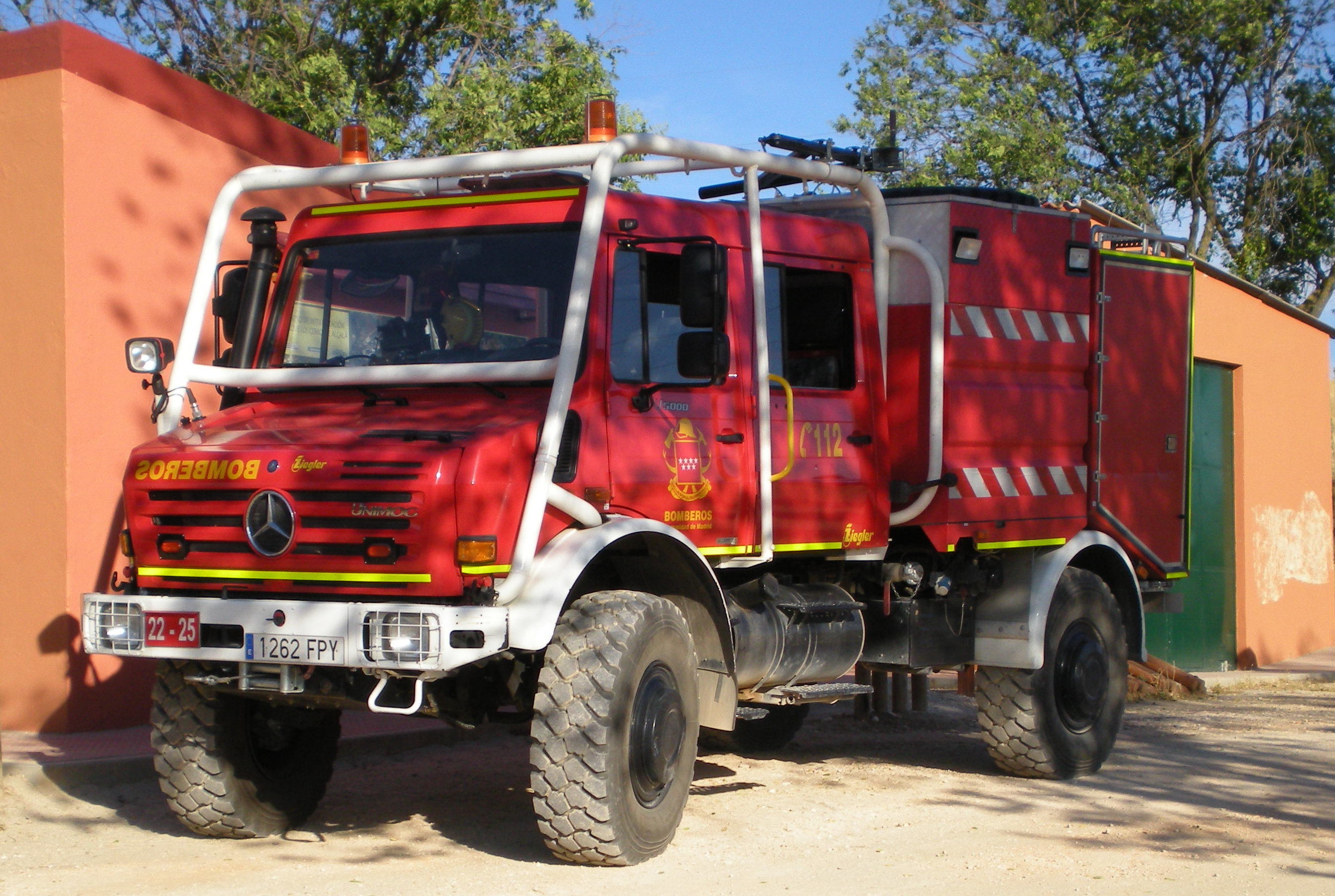
 The all-new range of UGN models ( 405 series U 300, U 400, U 500) was introduced in 2000.
In August 2002 production ended in the Gaggenau plant after 51 years and more than 320,000 Unimogs being made, and started up in Mercedes-Benz's truck manufacturing plant in Wörth am Rhein. The U 3000, U 4000 and U 5000 models (UHN 437.4 series) were introduced at the same time.
At the Dubai Motor Show in December 2005, the "Unimog U 500 Black Edition" premiered as an offering to wealthy desert-dwellers. It is a similar luxury offering comparable to the Funmog.
Starting from June 2006 the UGN series was produced with BlueTec technology so that the Euro IV emission requirements would be met. The design designations changed from 405.100 to 405.101.
At the IAA 2006 commercial vehicle show in Hanover a new Unimog'' U 20 '' was presented, which was to be available at the end of 2007. The most striking feature is the cab over design with no vestigial front bonnet characteristic of the traditional Unimog. It has a total mass of 7,500 kg up to 8,500 kg. The underlying technology comes from the U 300. The driving cab is from the new Brazilian Accelo light truck (Caminhões Leves) series. The wheelbase is shortened to .
The all-new range of UGN models ( 405 series U 300, U 400, U 500) was introduced in 2000.
In August 2002 production ended in the Gaggenau plant after 51 years and more than 320,000 Unimogs being made, and started up in Mercedes-Benz's truck manufacturing plant in Wörth am Rhein. The U 3000, U 4000 and U 5000 models (UHN 437.4 series) were introduced at the same time.
At the Dubai Motor Show in December 2005, the "Unimog U 500 Black Edition" premiered as an offering to wealthy desert-dwellers. It is a similar luxury offering comparable to the Funmog.
Starting from June 2006 the UGN series was produced with BlueTec technology so that the Euro IV emission requirements would be met. The design designations changed from 405.100 to 405.101.
At the IAA 2006 commercial vehicle show in Hanover a new Unimog'' U 20 '' was presented, which was to be available at the end of 2007. The most striking feature is the cab over design with no vestigial front bonnet characteristic of the traditional Unimog. It has a total mass of 7,500 kg up to 8,500 kg. The underlying technology comes from the U 300. The driving cab is from the new Brazilian Accelo light truck (Caminhões Leves) series. The wheelbase is shortened to .
2010s
In August 2013, production of the next generation models commenced at the Wörth plant. The new models feature redesigned cabins and new engines that were claimed to meet the Euro VI emission standards.Series names and identification notes
Unimog series numbers like 401, 406, or 425 in this article are the factory numerical designation (in German "Baumuster", literally ''Construction Pattern''). Unimogs also have a sales model number like U 80, U 120, or U 1350. Each series can have several model numbers, as they are equipped with different engines. The "U" model numbers were roughly equivalent to the horsepower of the engine (in German: PS). A 424.121 with a wheelbase equipped with the OM 352 engine is a U 1000. A 427.100 with a wheelbase and the 100-PS 366 engines is also a U 1000. Starting in 1976, model numbers have an extra 0 at the end. More recent models like the U 5000 are rated at .See also
* Bremach – similar vehicles built in Italy * Railcar mover * SCAM – similar vehicles built in Italy * Silant – similar vehicles built in Russia * Pinzgauer – similar vehicles built in AustriaNotes
References
Further reading
* *External links
Unimog Official Site
{{Commons category, Unimog vehicles Cab over vehicles Engineering vehicles Mercedes-Benz vehicles Military trucks Military vehicles of Germany Off-road vehicles Pickup trucks